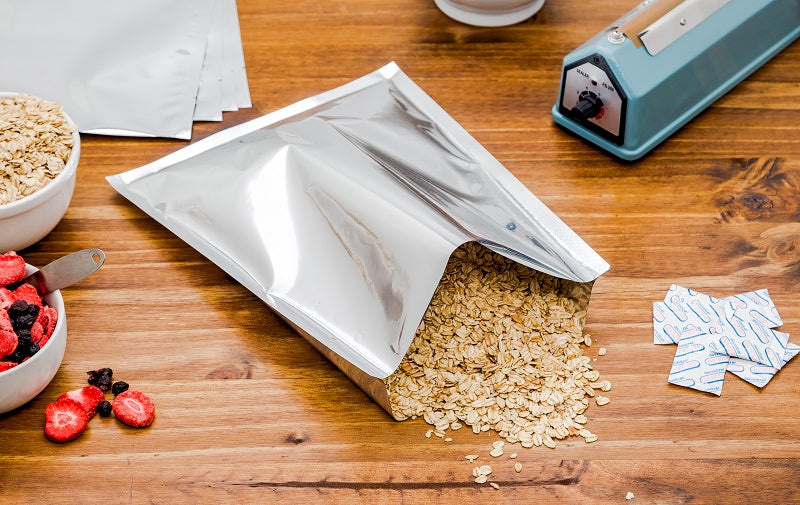Are you delving into long-term food storage to ensure preparedness for emergencies? If so, you've likely begun researching various methods for storing different food items over extended periods. Amidst these methods, the use of Mylar bags with oxygen absorbers stands out as a popular choice. While there's ample information available on Mylar bags, oxygen absorbers often receive less attention.
In this blog post, we aim to bridge that gap by providing comprehensive insights into oxygen absorbers. What are they? How do they function? When should you use them, and when should you abstain? Let's dive in.
What are Oxygen Absorbers?
Oxygen poses a significant threat to food products, particularly when aiming for long-term preservation. Excess oxygen can compromise the quality, color, texture, taste, and consistency of food items, making its removal imperative for prolonged storage.

Enter oxygen absorbers. These small packets are filled with Ferrous iron powder, a non-toxic chemical that absorbs oxygen from the surrounding environment to form iron oxide. When placed inside Mylar bags, oxygen absorbers create an oxygen barrier, preventing food spoilage. Additionally, the removal of oxygen inhibits bacterial growth and prevents the development of insect larvae.
A single sachet of oxygen absorber can eliminate up to 99% of the oxygen in the storage container, leaving behind inert air that does not affect food quality. This efficiency surpasses traditional oxygen removal methods like vacuum sealing.
Reasons to Use Oxygen Absorbers
Oxygen absorbers serve several vital functions in long-term food storage:
- They extend the shelf life of food, particularly dried items.
- Oxygen absorbers are ideal for storing home-dehydrated or store-bought dried foods.
- They facilitate the preservation of natural foods without the need for chemicals, additives, or preservatives.
- By preventing microbial growth, oxygen absorbers ensure food safety.
- They help maintain the flavor, color, and texture of food items by eliminating oxygen.
Furthermore, oxygen absorbers offer unmatched convenience. Simply place a sachet inside the sealed container, and your food remains preserved with minimal effort.
How Do Oxygen Absorbers Work?
Oxygen absorbers operate through a simple chemical reaction between iron and oxygen. As oxygen reacts with ferrous iron, it oxidizes and begins to rust. Sodium is added to the sachet to promote this reaction in low-humidity environments.
Multiple iron and oxygen molecules continue to react, forming iron oxide and steadily reducing oxygen levels within the sealed container. The powder in the packet remains separate from the food, ensuring its safety. Remarkably, oxygen absorbers generate warmth during this process, akin to disposable hand warmers. It typically takes about four hours for oxygen absorbers to remove oxygen from sealed containers or bags.
The Biggest Oxygen Absorber Error
While generally straightforward to use, there are crucial considerations to ensure their effectiveness. Oxygen absorbers commence their activity immediately upon exposure to air. Opening them prematurely, before your food is ready for storage, diminishes their efficacy, potentially rendering them ineffective. Some manufacturers provide indicators, such as color-changing pills, to signal the absorbers' activity status.
Alternatively, you can perform a tactile test by feeling the packet's contents. Loose powder indicates readiness for use, whereas a hardened or solid substance suggests diminished effectiveness. Proper storage is paramount to preserving the absorbers' potency.
How to Use Oxygen Absorbers

Follow these simple steps to effectively utilize oxygen absorbers for food preservation:
- Assess your requirements and determine the number of packets needed for your food.
- Prepare your food and place it in the chosen long-term storage container.
- Have a container ready to store leftover packets immediately after use.
- Seal the food container promptly upon inserting the packet.
- Store packages in a cool, dark, and dry location.
Where can/can't you use oxygen absorbers?
Oxygen absorbers are essential for certain dry foods and containers in long-term storage. However, they are unnecessary for others.
Cannot Be Used In
- Dry foods such as sugar, baking soda, baking powder, and salt do not require oxygen absorbers for long-term preservation.
- Foods with a moisture content exceeding 10%, like brown rice or beef jerky, do not benefit from oxygen absorbers.
Can be Used in
- Oxygen absorbers can be employed with any container type, including mason jars, Mylar bags, and plastic containers, provided the food has a moisture content below 10%.
How Many Packets Should I Use?
Determining the appropriate number of oxygen absorbers involves calculating the container's residual air volume. It's advisable to add extra absorbers to err on the side of caution. Available in various sizes, common options include 500cc and 2500cc packets. Combining packets allows for customization to suit specific storage volumes.
Do Oxygen Absorbers Do the Same Job as Vacuum Packaging or Freezing?
While freezing and vacuum packaging are viable preservation methods, they do not replicate the efficacy of oxygen absorbers. Freezing prolongs the shelf life of certain foods but does not eliminate oxygen. Vacuum packaging removes air but does not target oxygen specifically. Oxygen absorbers, on the other hand, effectively remove oxygen, safeguarding food quality over extended periods.
Other Things to Keep in Mind
Successful long-term food storage requires consideration of additional factors:
- Light exposure should be minimized, with foods stored in dark, dry locations.
- Maintaining temperatures at or below room temperature is crucial, with extremes avoided.
- Moisture levels should be minimized to prevent condensation, which hastens food spoilage.
Bottom Line
Oxygen absorbers are indispensable for long-term food storage, ensuring food remains fresh and safe for consumption. Understanding their usage and limitations is key to effective preservation. While Mylar bags typically necessitate oxygen absorbers, exceptions exist. For all your long-term food storage needs, explore our selection of premium Mylar bags and oxygen absorbers at Wallaby.
Visit our store today to embark on your long-term food storage journey with Wallaby!
SHARE:





